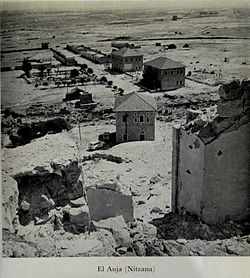- Auja al-Hafir
-
Auja al-Hafir 
'Arabic عوجة الحفير Also Spelled El Audja[1] District Beersheba Coordinates 30°52′56″N 34°23′38″E / 30.88222°N 34.39389°ECoordinates: 30°52′56″N 34°23′38″E / 30.88222°N 34.39389°E Population 48 (1948)[2] + 3,500 'Azazme[3] Area Date of depopulation 1967-06-10[4] Cause(s) of depopulation Military assault by Yishuv forces Current localities Nessana Auja al-Hafir, also Auja, was an ancient road junction close to water wells[5] in the western Negev and eastern Sinai. It was the traditional grazing land of the 'Azazme tribe. The border crossing between Egypt and Ottoman/British Palestine, about 60 km south of Gaza, was situated there. Today it is the site of Nitzana in the Southern District of Israel.
Contents
Etymology
Other sources name the locality el-Audja, 'Uja al-Hafeer, El Auja el Hafir and variations thereof.
History
The Ottoman Empire built a police station in 1902. Before World War I it was the site of a military base.[6] From 1905 to 1915 there were built a railroad and a large administrative centre together with administrators apartment building.[7] In the middle of January, 1915, a Turkish Army force of 20,000 entered Sinai by way of El Auja on an unsuccessful expedition against the Suez Canal.[8]
The central route across the desert to the Suez Canal crossed from El Auja to Ismailia, until 1948 this was the only paved road between Palestine and Egypt.[9] During the British Mandate of Palestine it was part of the District of Beersheba.[10] During the British Mandate the location was a prison camp.[11]
According to the United Nations Partition Plan for Palestine, the area was designated as part of the Arab state. In 1948 the Egyptian Army used the area as a military base.[11] In the Battle of 'Auja, a campaign of the 1948 Arab–Israeli War, it was captured by the 89th Mechanized Commando Battalion, which had an English-speaking platoon of volunteers from England, Germany, Holland, Rhodesia, South Africa, and the U.S.[12]
As a result of the 1949 Armistice Agreements, the area around the village, known as the al-Auja Zone, became a 145 km2 demilitarized zone (DMZ), with compliance monitored by the United Nations Truce Supervision Organization (UNTSO). On 28 September 1953 the Israeli army established a fortified settlement, Ktzi'ot, overlooking the al-Auja junction. The first name given to this Nahal outpost was Giv'at Rachel.[13] Despite a recent request for compliance with the armistice, Israel re-militarized the area on September 21, 1955. Israel continued to occupy the area until after its withdrawal from Sinai and Gaza, which ended the 1956 Suez Crisis. After this, and until the Six-Day War, the DMZ and the border were monitored by the United Nations Emergency Force. Israel has controlled the area since 1967.
See also
- Nitzana Border Crossing
- Battles of Bir 'Asluj
References
- ^ El Audja on www.citymaphq.com
- ^ Encyclopedia of the Palestine Problem by Issa Nakhleh, Chapter 12, Part 4 of 4
- ^ Burns, Lieutenant-General E.L.M. (1962) Between Arab and Israeli. George G. Harrap. Pages 92, 93
- ^ Israel Districts on statoids.com
- ^ Glossary of Israeli Parties and Personalities - 1948-1981 published by the Jerusalem Centre for Public Affairs
- ^ Archaeological Encyclopedia of the Holy Land by Shimon Avraham Negev, p 367
- ^ Naburiya Synagogue and Nitzana Farm by Yaakov Skolnik published 2007-10-04, 17:01 by ynetnews.com
- ^ MacMunn, Lieut.-General Sir George (1928) Military Operations. Egypt and Palestine. From the outbreak of war with Germany to June 1917. HMSO. Pages 34,35.
- ^ Neff, Donald (1988) Warriors at Suez. Eisenhower takes America into the Middle East in 1956. Amana Books. ISBN 0 915597 6. Page 112. "Control of the 145 square kilometer zone of El Auja, called Nitzana in Hebrew, was imperative for an attack across the sandy wastes of north-central Sinai. The zone centered on an important road junction, with roads leading north to the coast and west to the Suez Canal, the only paved road directly connecting Palestine and Egypt at the time."
- ^ Passport Palestine: Visit a Cyber Palestine city, town or village
- ^ a b Nizzana, Beersheba at planetware.com
- ^ Overseas volunteers in Israel's War of Independence Internet Edition 2007 Jerusalem No. 5763 Author: Dr. Yaacov Markovitzky with contributions from Zipporah Porath, Eddy Kaplansky and Joe Woolf. Translation from the Hebrew: Moshe Kohn. Page 32
- ^ Morris, Benny (1993) Israel's Border Wars, 1949 - 1956. Arab Infiltration, Israeli Retaliation, and the Countdown to the Suez War. Oxford University Press, ISBN 0 19 827850 0. Page 356.
Bibliography
- Israel Unit in Neutral Zone, Strategic Village Occupied, The Times, September 21, 1955, page 8.
- Ending Strife in Auja Zone, Egypt Accepts U.N. Plan, Mr. Hammarskjöld's Statement, The Times, January 25, 1956, page 8.
Further reading
- Nitzana (Auja El-Hafir) Memorial Board For The 1948 Independence War Fighters In The Negev
- P. Colt. No. 60 - A Bilingual Entagion From The Year 54 AH / 674 CE
- Australian War Memorial AWM Collection Record: P02041.015
- Australian War Memorial AWM Collection Record: P02041.008
- Detailed map of 1953 with Al Āwja Neutral Zone
Categories:- Geography of Palestine
- History of Palestine
- Geography of Israel
Wikimedia Foundation. 2010.


